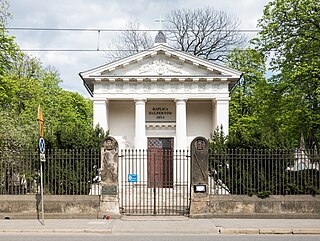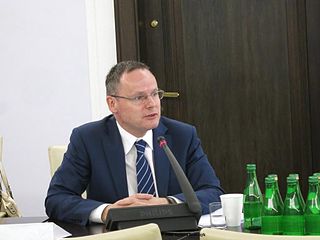Warschau may refer to:
- German name of Warsaw, Poland
- Warschau (album)
- KL Warschau, or Warsaw concentration camp, Nazi concentration camp in the city
Warschau may refer to:

The Warsaw Ghetto was the largest of the Nazi ghettos during World War II and the Holocaust. It was established in November 1940 by the German authorities within the new General Government territory of occupied Poland. At its height, as many as 460,000 Jews were imprisoned there, in an area of 3.4 km2 (1.3 sq mi), with an average of 9.2 persons per room, barely subsisting on meager food rations. From the Warsaw Ghetto, Jews were deported to Nazi concentration camps and mass-killing centers. In the summer of 1942, at least 254,000 ghetto residents were sent to the Treblinka extermination camp during Großaktion Warschau under the guise of "resettlement in the East" over the course of the summer. The ghetto was demolished by the Germans in May 1943 after the Warsaw Ghetto Uprising had temporarily halted the deportations. The total death toll among the prisoners of the ghetto is estimated to be at least 300,000 killed by bullet or gas, combined with 92,000 victims of starvation and related diseases, the Warsaw Ghetto Uprising, and the casualties of the final destruction of the ghetto.

Mauthausen was a Nazi concentration camp on a hill above the market town of Mauthausen, Upper Austria. It was the main camp of a group with nearly 100 further subcamps located throughout Austria and southern Germany. The three Gusen concentration camps in and around the village of St Georgen/Gusen, just a few kilometres from Mauthausen, held a significant proportion of prisoners within the camp complex, at times exceeding the number of prisoners at the Mauthausen main camp.
Warsaw is the capital of Poland.

The Warsaw Ghetto Uprising was the 1943 act of Jewish resistance in the Warsaw Ghetto in German-occupied Poland during World War II to oppose Nazi Germany's final effort to transport the remaining ghetto population to Majdanek and Treblinka death camps.

In the German language, Festung Warschau is the term used to refer to a fortified and well-defended Warsaw. In the 20th century, the term was in use on three occasions during World War I and World War II. It was used when the Germans threw back the Russian advance in 1914, where Warsaw came within distance of the fighting in October. The term resurfaced during the September 1939 German invasion of Poland. Later in the second war, the term resurfaced between September 1944 and January 1945, when the retreating Germans tried to establish a defense in the city against the advancing Soviet Union.

The Warsaw concentration camp was a German concentration camp in occupied Poland during World War II, formed on the base of the now-nonexistent Gęsiówka prison, in what is today the Warsaw neighbourhood of Muranów. It was created on the order of Reichsführer-SS Heinrich Himmler and operated from July 1943 to August 1944.

Gęsiówka is the colloquial Polish name for a prison that once existed on Gęsia ("Goose") Street in Warsaw, Poland, and which, under German occupation during World War II, became a Nazi concentration camp.
Festung is a generic German word for a fortress. Although it is not in common usage in English, it is used in a number of historical contexts involving German speakers:
Fortress Warsaw may refer to:

Ferdinand von Sammern-Frankenegg was an Austrian SS functionary during the Nazi era. He was born in Grieskirchen. Von Sammern-Frankenegg served in World War I as a member of the Kaiserschützen, then of the K.u.k. Feldjäger and then after Austria-Hungary had formally surrendered, in the German Freikorps Oberland and the Steirischer Heimatschutz. Ferdinand von Sammern-Frankenegg earned his PhD in legal studies at the University of Innsbruck in 1922. He had been a member of the dueling fraternity Universitätssängerschaft Skalden zu Innsbruck. Von Sammern-Frankenegg worked as a lawyer in Peuerbach.

The destruction of Warsaw was Nazi Germany's substantially effected razing of the city in late 1944, after the 1944 Warsaw Uprising of the Polish resistance. The uprising infuriated German leaders, who decided to destroy the city as retaliation.

The Pabst Plan was a Nazi German urban plan to reconstruct the city of Warsaw as a Nazi model city. Named after its creator Friedrich Pabst, the Nazis' "Chief Architect for Warsaw", the plan assumed that Warsaw, the historical capital of Poland and a city of 1.5 million inhabitants, would be completely destroyed and rebuilt as a small German town of not more than 130,000 inhabitants.

Franz Konrad was an Austrian mid-level commander in the SS of Nazi Germany who was an administrative official responsible for the Werteerfassung or "recording of valuables" in the Warsaw Ghetto. He earned the nickname "the King of the Warsaw Ghetto". In March 1952, Konrad was executed by hanging in Warsaw.

Krasiński Library was a library in Warsaw, founded in 1844. During the German invasion and occupation of Poland, part of the building was destroyed and its collections were stolen, redistributed, or burned. Its surviving collections are now at the National Library of Poland.

(Polish: Cmentarz ewangelicko-augsburski w Warszawie), The Evangelical Lutheran Cemetery of the Augsburg Confession in Warsaw is a historic Lutheran Protestant cemetery located in the Wola district, western part of Warsaw, Poland.

Bogusław Tadeusz Kopka – a Polish historian, PhD, a professor at the Akademia Zamojska; an associate professor at the Warsaw University of Technology Faculty of History and Social Sciences and at the Warsaw Family Alliance Institute of Higher Education.

Maria (Marianna) Trzcińska was a Polish judge employed for over 30 years in the People's Republic of Poland at the Chief Commission for the Investigation of Nazi Crimes in Poland. She investigated and researched German World War II crimes in Poland.
Nikolaus Herbet was a German SS officer and the second and last commandant of Warsaw concentration camp, during the period from September 1943 to July 1944. He was preceded in this function by Wilhelm Göcke.
Executions in the ruins of the Warsaw Ghetto (1943–1944) – mass executions of Polish Political prisoners and people of Jewish descent carried out secretly by German occupiers in the ruins of the Warsaw Ghetto.
Warsaw District was one of the first four Nazi districts of the General Governorate region of German-occupied Poland during World War II, along with Lublin District, Radom District, and Kraków District. It was bordered on the north by Regierungsbezirk Zichenau and Bezirk Bialystok. The region contained more than 60 Nazi ghettos including the Warsaw Ghetto.